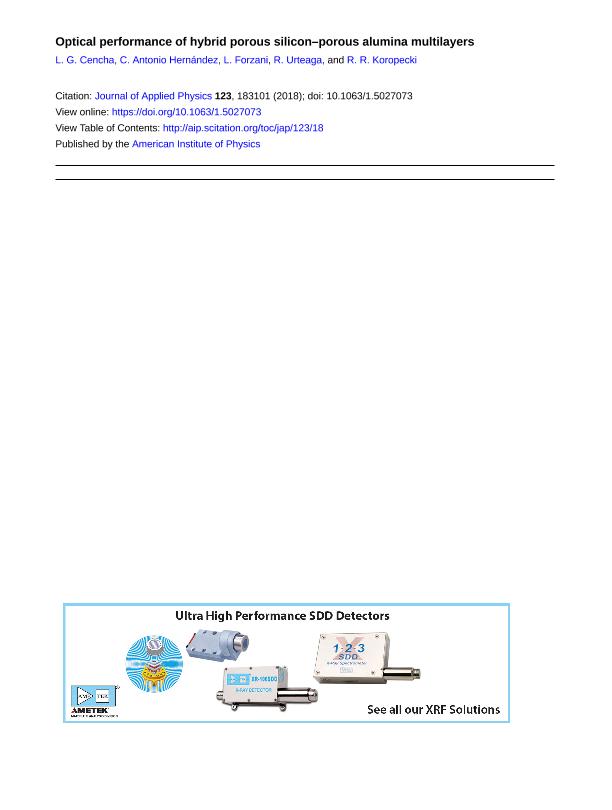Mostrar el registro sencillo del ítem
dc.contributor.author
Cencha, Luisa Guadalupe

dc.contributor.author
Antonio Hernández, C.
dc.contributor.author
Forzani, Luisina

dc.contributor.author
Urteaga, Raul

dc.contributor.author
Koropecki, Roberto Roman

dc.date.available
2019-10-15T13:49:22Z
dc.date.issued
2018-05
dc.identifier.citation
Cencha, Luisa Guadalupe; Antonio Hernández, C.; Forzani, Luisina; Urteaga, Raul; Koropecki, Roberto Roman; Optical performance of hybrid porous silicon-porous alumina multilayers; American Institute of Physics; Journal of Applied Physics; 123; 18; 5-2018; 1-9
dc.identifier.issn
0021-8979
dc.identifier.uri
http://hdl.handle.net/11336/85870
dc.description.abstract
In this work, we study the optical response of structures involving porous silicon and porous alumina in a multi-layered hybrid structure. We performed a rational design of the optimal sequence necessary to produce a high transmission and selective filter, with potential applications in chemical and biosensors. The combination of these porous materials can be used to exploit its distinguishing features, i.e., high transparency of alumina and high refractive index of porous silicon. We assembled hybrid microcavities with a central porous alumina layer between two porous silicon Bragg reflectors. In this way, we constructed a Fabry-Perot resonator with high reflectivity and low absorption that improves the quality of the filter compared to a microcavity built only with porous silicon or porous alumina. We explored a simpler design in which one of the Bragg reflectors is replaced by the aluminium that remains bound to the alumina after its fabrication. We theoretically explored the potential of the proposal and its limitations when considering the roughness of the layers. We found that the quality of a microcavity made entirely with porous silicon shows a limit in the visible range due to light absorption. This limitation is overcome in the hybrid scheme, with the roughness of the layers determining the ultimate quality. Q-factors of 220 are experimentally obtained for microcavities supported on aluminium, while Q-factors around 600 are reached for microcavities with double Bragg reflectors, centred at 560 nm. This represents a four-fold increase with respect to the optimal porous silicon microcavity at this wavelength.
dc.format
application/pdf
dc.language.iso
eng
dc.publisher
American Institute of Physics

dc.rights
info:eu-repo/semantics/openAccess
dc.rights.uri
https://creativecommons.org/licenses/by-nc-sa/2.5/ar/
dc.subject
photonic crystals
dc.subject
microcavities
dc.subject
optical sensors
dc.subject.classification
Óptica

dc.subject.classification
Ciencias Físicas

dc.subject.classification
CIENCIAS NATURALES Y EXACTAS

dc.title
Optical performance of hybrid porous silicon-porous alumina multilayers
dc.type
info:eu-repo/semantics/article
dc.type
info:ar-repo/semantics/artículo
dc.type
info:eu-repo/semantics/publishedVersion
dc.date.updated
2019-10-10T14:58:20Z
dc.journal.volume
123
dc.journal.number
18
dc.journal.pagination
1-9
dc.journal.pais
Estados Unidos

dc.journal.ciudad
New York
dc.description.fil
Fil: Cencha, Luisa Guadalupe. Consejo Nacional de Investigaciones Científicas y Técnicas. Centro Científico Tecnológico Conicet - Santa Fe. Instituto de Física del Litoral. Universidad Nacional del Litoral. Instituto de Física del Litoral; Argentina
dc.description.fil
Fil: Antonio Hernández, C.. Benemérita Universidad Autónoma de Puebla; México
dc.description.fil
Fil: Forzani, Luisina. Consejo Nacional de Investigaciones Científicas y Técnicas. Centro Científico Tecnológico Conicet - Santa Fe. Instituto de Física del Litoral. Universidad Nacional del Litoral. Instituto de Física del Litoral; Argentina
dc.description.fil
Fil: Urteaga, Raul. Consejo Nacional de Investigaciones Científicas y Técnicas. Centro Científico Tecnológico Conicet - Santa Fe. Instituto de Física del Litoral. Universidad Nacional del Litoral. Instituto de Física del Litoral; Argentina
dc.description.fil
Fil: Koropecki, Roberto Roman. Consejo Nacional de Investigaciones Científicas y Técnicas. Centro Científico Tecnológico Conicet - Santa Fe. Instituto de Física del Litoral. Universidad Nacional del Litoral. Instituto de Física del Litoral; Argentina
dc.journal.title
Journal of Applied Physics

dc.relation.alternativeid
info:eu-repo/semantics/altIdentifier/doi/http://dx.doi.org/10.1063/1.5027073
dc.relation.alternativeid
info:eu-repo/semantics/altIdentifier/url/http://pubs.rsc.org
Archivos asociados
